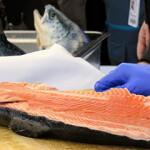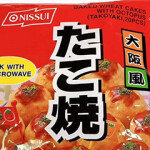Breakthrough survival rate announced in octopus aquaculture research

Advances in the captive breeding and rearing of the East Asian common octopus (Octopus sinensis) were presented in a seminar on 17 March at the 18th Seafood Show Osaka.
In the seminar, organized by the Japan Fisheries Research and Education Agency (FRA), Ayami Sekizawa of the Aquaculture Research Department, of FRA’s Fisheries Technology Institute, discussed her team’s achievements, centered on techniques to reduce mortality in the paralarva stage, and a tank division system that reduces cannibalism.
Massive mortalities during the paralarvae stage, when the young cephalopods are in a planktonic form between hatchling and subadult, have been the major obstacle to commercialized closed-cycle octopus aquaculture.
The first issue discussed was the tendency for the paralarvae to be carried downward in a current induced by the aeration system, eventually depositing the animals on the tank bottom. In a system with an aerator in the middle of the tank, a flow is created by the rising bubbles in the center. The water then returns downward along the tank sides carrying the paralarvae with it. As the paralarvae have poor ability to swim at this stage, they are mainly passively drifting. With this system, they remain at the bottom of the tank. If they manage to rise, they are again caught in the current and redeposited at the bottom.
In the research, a two-tank system was employed. The water was aerated in one tank and then pumped with a downward-facing pipe into the center of the round rearing tank. This avoided the release of bubbles in the tank and the downward flow of the water resulted in a gentle rising of the water at the sides of the tank, lifting the paralarvae off the tank floor.
The second issue discussed was the choice of feed. Brine shrimp larvae (Artemia nauplii) is a common aquaculture feed for juvenile fish, but the study confirmed that octopus survival is improved by feeding mainly zoea (free-swimming larvae) of the gazami swimming crab (Portunus trituberculatus).
These experiments were reported in a study published in issue #495 of Aquaculture magazine, under the title “An upwelling system for culturing common octopus paralarvae and its combined effect with supplying natural zooplankton on paralarval survival and growth.”
The third issue discussed was housing. A common practice has been to keep all octopuses together and to place a few semi-cylindrical shelters on the tank floor for the octopuses to hide in. However, octopuses in such a system become territorial and cannibalistic. A new system of dividers (resembling cubicles in an office) that divides the tank with a separate space for each animal was introduced and was found to prevent cannibalism, though it makes cleaning more difficult.
With these three methods, the research achieved a 10-month survival rate of 46.8 percent and a 12-month survival of 41.6 percent. The large increase in survival over that of previous research opens the door to commercial indoor tank-farmed octopus production. As a result of breeding 156 juvenile octopus using the newly-developed isolated rearing dividers to prevent cannibalism, 73 individuals survived to 10 months, of which 65 individuals reached the shipping size of 500 grams in weight. Of these, 25 individuals exceeded one kilogram – the target weight at harvest for farmed octopus, though weights between 500 grams and 1,500 grams are in the salable range.
The whole series of steps for closed-cycle breeding and rearing of octopus can now be performed in indoor tanks, so the program has adopted the catch-phrase “Octopus that doesn’t know the sea!”
The three-year project, named (in translation) “Innovation Creation Enhancement Research Promotion Project, Development of Basic Technology for Commercialization of Common Octopus Culture,” ran from 2018 through 2020. Initial results were announced in September 2020, and were also presented at the 22nd Japan International Seafood and Technology Show.
Going forward, the research will focus on scaling up to mass production and on developing technology for securing a large amount of feed. Sekizawa said that the cost of securing the crab zoea is the next major hurdle to overcome, with the development of a formulated feed that could replace the zoea having the potential to bring costs down considerably.
Photo courtesy of Chris Loew/SeafoodSource






Share